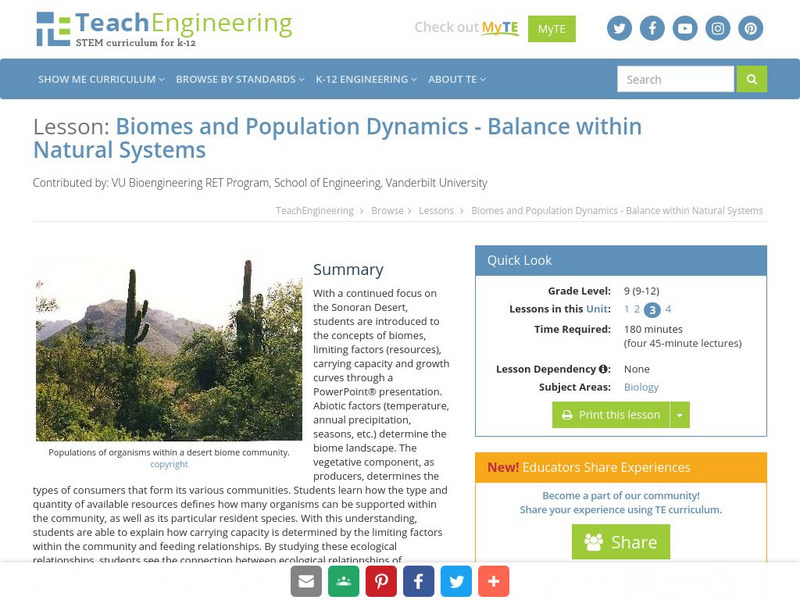Hi, what do you want to do?
Curated OER
Estuarine Habitats
Sixth graders study the important habitats, flora, fauna, and physical factors of coastal habitats. They compare the aquatic habitats to terrestrial habitats by researching and completing tables with the information.
Curated OER
Asexual versus Sexual Reproduction
Young scholars explore reproduction. They research organisms and groups of organisms to determine whether they reproduce sexually or asexually. In addition, they determine the organism's habitat.
Curated OER
The Changing Coral Reef
Learners record changes in the composition of a coral reef. In this Coral Reef instructional activity, students recognize the needs of Coral Reef species to survive. Learners chart changes in population over time. Students...
Curated OER
I See a Coyote
Students role-play coyotes looking for natural resources. In this natural resources lesson, students examine the relationship between animal life and the environment. Students play a game that demonstrates how natural...
Curated OER
"Oh Deer!"
Students play a game where half of them are deer and the others are components of habitat: food, water, shelter and space. They signify their needs by hand gestures and take what they need to their side of the game. They discuss real...
Curated OER
Saving the Bay
Students investigate water pollution prevention. In this ecology wastewater instructional activity, students activate prior knowledge about sewage, then view a video explaining the waste water sewage system used in the San Francisco Bay...
Curated OER
Leaf - It's What's for Dinner
Middle schoolers discover correlations in food preferences of invertebrates, and assess stream health through use of kicknets, invertebrate keys, CBL systems and probes.
Curated OER
Genetic Disorders with Cultural Roots: International Insects
Students recognize that certain populations have specific genetic disorders that could benefit or harm them in their environment, work out punnett square problems and infer offspring probabilities from results, and provide advantages and...
Curated OER
Field Experiments on Succession
Student develop a hypothesis regarding the effects of either mowing or fertilizer upon the diversity of plant species in a grassland ecosystem. They set up experiment field plots and measure species richness.
Curated OER
Raising an Animal
Students observe reproduction and behavior in several types of animals and nurture a sense of responsibility and cooperation. They then examine external features of several different types of animal groups.
Curated OER
Aquatic Insects: Water Quality Index & Diversity Index
Students search stream beds to study the life cycle and adaptations of stream insects. They explore creeks and streams to see the diversity index of creeks or streams and to find the water qualit index.
Curated OER
Primary Producers
Students examine the role of carbon in the oceans and how phytoplankton determine the levels present. In groups, they practice measuring primary productivity using two methods. They use the internet to research the role of phytoplankton...
Curated OER
Farming in a Fishbowl: How Ethnic Groups in
Seventh graders research Chinese agricultural needs and practices. They conduct an experiment with aquaculture and germinated rice as they take measurements and apply the scientific method.
Curated OER
Native Species Restoration: Is Saving One Species Hurting Another?
Students investigate the effect of human activities upon the environment. The studying experience encourages students to think about the issues involved in native species restoration.
Oswego City School District
Regents Exam Prep Center: Biotic vs. Abiotic
This NY Regents prep site provides a nice overview of what abiotic and biotic factors of an ecosystem are, as well as a brief description of carrying capacity.
TeachEngineering
Teach Engineering: Biomes and Population Dynamics
This lesson begins with a PowerPoint slideshow that covers important ecological concepts about biomes, limiting factors, carrying capacity, and population growth. Students will look at the population dynamics involved with the diversity...
TeachEngineering
Teach Engineering: Designing a Sustainable Guest Village
This lesson introduces students to their task of designing a permanent guest village within the Saguaro National Park. The design must provide a true desert experience to visitors while also emphasizing sustainable design, protection of...
The Association of the British Pharmaceutical Industry
Abpi: Population Growth
Students control the environments in four different scenarios to discover how any changes might affect populations. The different simulations include microorganisms, rabbits, foxes, and other organisms.
Oswego City School District
Regents Prep: Ecosystems/communities
Abiotic factors vary in the environment and determining the types and numbers of organisms that exist in that environment. Factors which determine the types and numbers of organisms of a species in an ecosystem are called limiting...
National Institute of Educational Technologies and Teacher Training (Spain)
Ministerio De Educacion: Los Seres Vivos Y El Medio Ambiente
What is ecology? What is a biome? You will find the answers to these questions in this unit and also learn about the organization of the Biosphere, major Biomes of the earth and the adaptations of living things to limiting factors. It...
























